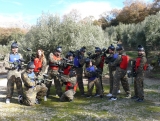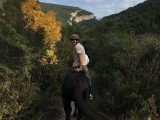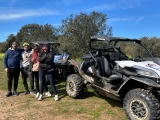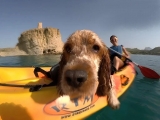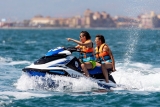How to correctly assemble your equipment
First, we have the lightweight equipment: mask, snorkel, fins. Regarding the snorkel, we'll position it on our left for convenience to avoid any difficulty when switching to the regulator (regulators are typically placed on the right for right-handed divers; if you're left-handed, reverse this and place the snorkel on the left).

Next, we'll place the cylinder vertically and securely supported on the ground. It's certainly not unheard of for one to topple over on land (due to rocks or uneven ground) or on the boat, causing damage or, worse, injury. So let's ensure its stability – the less time it spends unsecured in an upright position, the better. Then, we'll take the BCD (Buoyancy Control Device) and, before assembling, it's best to check after oral and automatic inflation that the valves work and release air perfectly.
Different methods of securing to the cylinder
Typically, there's a strap or handle that allows us to loop around the cylinder valve, keeping it secured. We position it carefully, ensuring the BCD aligns with the air outlet on the valve. With our knee, we'll hold it so that it sits about two or three fingers' width above the valve. Next, we'll take the webbing strap to loop around the cylinder, noting that the left end of the strap has a terminal with a buckle system featuring four holes.The one closest to the strap is usually metal, followed by a plastic piece with three more holes. To make adjusting the strap easier, we'll refer to the metal buckle as number 0, followed by 1, 2, and 3. Simply pass the strap from your right through 0, then through number 2, give the plastic buckle a half-turn, and this will allow us to thread the strap through number 1. Here, we'll tighten it as much as possible, ensuring the straps are taut around the cylinder, and finally, pass it through number 3. In other words, if we consider zero as an even number, we could say we pass the strap through the "even" holes first, then the "odd" ones. Close the buckle to tighten the strap and secure the strap end with Velcro to the cylinder.

Once this is done, we'll check the BCD is securely attached to the cylinder by grabbing the handle on the top of the backplate and lifting it off the ground. If the cylinder doesn't slip and the straps stay fixed to the cylinder as positioned, the BCD is correctly fitted.
Next, we'll check the O-ring is in perfect condition. We'll attach the regulator to the cylinder valve, ensuring both the primary and secondary (octopus) regulators are on our right, while the BCD hose and console with pressure gauge and depth gauge remain on our left.
Secure each hose in its designated place on the BCD. Open the cylinder valve slowly, check for correct pressure, then close it and lay it on the ground, ensuring the BCD protects both regulators and any other instruments in the setup.
How should we enter the water?
When entering the water, remember to open the tank valve fully and then turn it back a quarter.
Giant stride entry
Once suited up with weights and near the entry point, we'll put on our fins and BCD with the regulator, then approach the pool edge or jumping spot. When ready, slightly inflate the BCD.Put on the mask and regulator, always looking at the horizon, holding them with your right hand. With the other hand, hold the console and hose to prevent them from hitting your face upon entry. Take a long step forward, letting yourself fall into the water. With the BCD slightly inflated, you'll float to the surface in seconds. Once up, give your buddy the OK signal to confirm everything's fine.

When diving from a boat, wait for the captain's authorisation before jumping. They'll confirm the boat is properly anchored with the engine off, advise on currents, their direction, and the boat's position relative to the dive site.
Backward roll entry from a low gunwale
From a boat with a low gunwale, it's easier to enter sitting with your back to the sea. Sit at the entry point, ideally with fins and regulator already on, assisted by your buddy or captain. Again, put on the mask and regulator, slightly inflate the BCD, check it's safe to enter without hitting anything, hold the mask and regulator with your right hand, and the mask strap with your left to prevent it from snapping back.Position your bottom as far out as possible and roll backwards, keeping an L-shaped posture while watching your fin tips. Surface, signal OK to your buddy, then swim to the anchor line to assist others and wait for your buddy.
How to gear up in the water?
If diving from a cove, enter the water wearing your wetsuit, weights, mask, and fins. Walk sideways or backwards carefully, dragging the floating regulator behind. If using a BCD with adjustable shoulder straps, loosen them.
Next, fully open the BCD, ensuring no hoses or gear are on top. Deflate slightly, insert one arm through its strap while sitting on the cylinder's "base," then insert the other arm. Finally, adjust the BCD by tightening shoulder straps and securing the waist Velcro.

In calm seas (especially without currents), the same applies when diving from a boat.
How to equalise correctly. Different techniques
We've all heard divers complain post-dive about ear pain or struggling to descend due to discomfort. Usually, this stems from poor equalisation.Equalisation techniques balance pressure between the middle ear and external environment, preventing eardrum deformation from water pressure. To avoid trauma, don't wait for pain – start equalising immediately upon submersion (especially during the first few metres) and continue until reaching the bottom, particularly on early dives.
There are three techniques for descent: Valsalva, Frenzel, Delonca A.T.V. The Toymbee manoeuvre is reserved for ascent.
- The most common is the Valsalva manoeuvre: pinch your nose and gently exhale through it with your mouth closed. With your tongue against your palate, you'll hear a slight pop in both ears, indicating success. Sometimes one ear equalises before the other.
- Frenzel manoeuvre: Pinch your nose, keep your glottis closed, and make a "K" sound with your tongue base, creating a "lingual piston effect."
- Delonca manoeuvre (Voluntary Tubal Opening): Only about 50% of divers can do this, as it requires highly permeable Eustachian tubes. Pinch your nose, keep your mouth closed with your tongue against your palate, tense and lift your soft palate. Focus on its position while the tube is open, then release your nose while maintaining palate position. Practice first without pinching.
- Toymbee manoeuvre: Used only during ascent or after decompression chamber sessions. Normally, ears equalise spontaneously during ascent. It involves swallowing to relieve internal pressure.

Using your lungs to achieve underwater balance
This is a subtle but game-changing technique for buoyancy control. Start shallow – ideal for pool practice.
Descend while equalising until you reach the bottom. Lie face down. Inflate the BCD slightly until your chest rises about two hand spans off the bottom. Inhaling will lift your chest further; exhaling returns you to the starting position. Mastering this lets you use your lungs as a secondary buoyancy aid, reducing constant BCD adjustments and saving energy/air. Remember: never ascend with lungs full of pressurised air without exhaling, especially near the surface, to avoid pulmonary barotrauma.
Why you shouldn't leave gear components loose
Once assembled, your setup includes: two regulator hoses (primary and octopus), plus the BCD hose and console hose.That's four hoses. Left loose, at best your octopus might drag through sand; at worst, it could snag, damage reefs, or harm marine life.
Most modern BCDs have dedicated attachment points. If yours doesn't, accessories are available for this purpose.
How to replace your regulator underwater
If you need to remove/replace your regulator (e.g., for oral inflation or switching to the octopus), remember it'll contain water when reinserted. Clear it by exhaling before inhaling. If low on air, press the purge button after reinsertion to instantly clear water.How to hand equipment to the boat crew post-dive?
When diving from a low-gunwale boat, first hand your weights to the captain. Hold the belt opposite the buckle to prevent drops/injury. Remember: you won't feel the weight underwater, but you will when handing it over – practice this early on.
After the weight belt, remove your BCD with the regulator and pass it up by pushing the cylinder base while they pull the BCD handle. Finally, approach the ladder (if available), remove your fins, and wear them on one arm by threading your hand through the straps like bracelets – this keeps them secure if you fall back in.
You could hand them to crew, but I recommend the first method to keep fins accessible for retrieval.
Remove your mask only when aboard or out of the water – keeping it on prevents loss if you fall back in and protects it from damage.
Some boats have open ladders (even elevators!) allowing boarding without removing gear. Once aboard, have your buddy help remove your regulator due to potential boat movement.

Disassembling and rinsing gear
Back at port, dive complete. Disassemble equipment as follows: close the valve, purge regulators, unscrew from the cylinder valve, and fit the dust cap to protect the regulator's first stage. Unbuckle the BCD straps. Lay the cylinder down to prevent accidental knocks.In dedicated freshwater tanks at dive centres, rinse your gear. Typically, there's one tank for delicate items (kept cleaner) and another for the rest. Don't rinse wetsuits and booties where regulators/computers go. When rinsing regulators, don't purge during rinsing – this could introduce freshwater into the second stage, where movement might carry it to the first stage. Any trapped freshwater could leave deposits, causing damage.
After regulators, check if the BCD contains seawater. Drain it via the inflator hose or dump valves. Rinse thoroughly, ensuring freshwater flows through all valves/hoses to remove salt. Then rinse your wetsuit, booties, fins, mask, snorkel, and weight belt. A quick hose-down of the cylinder helps too.
After rinsing, dry gear thoroughly – never in direct sunlight (to prevent rubber degradation/colour fading). Before storage, ensure everything is completely dry – turn booties inside out, hang wetsuits inverted, then right-side out to confirm dryness. Otherwise, odours and mould may develop.
For storage, hang wetsuits rather than folding them. Neoprene contains thousands of air bubbles – frequent folding creases can compress these, damaging the material. Fold only for transport, and sparingly.





